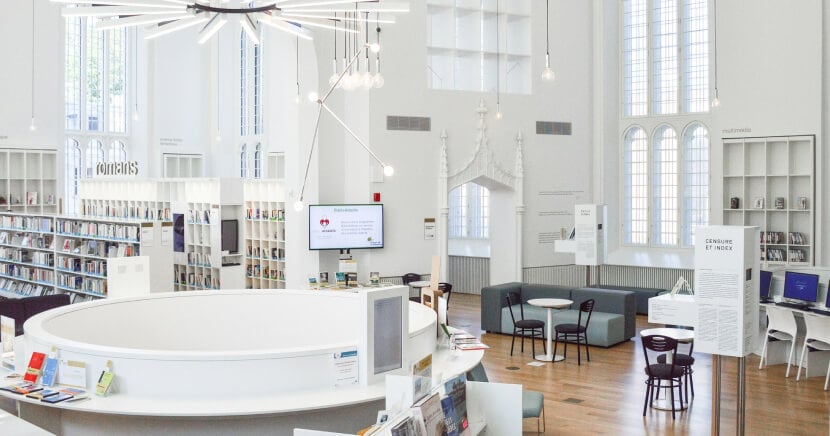Recently I was researching an article on how libraries are transforming themselves to better serve their patrons in the digital age. I discovered a number of academic and public institutions that diversified themselves to address the needs of today’s consumer, but Princeton Public Library (PPL) went many steps further by not only diversifying their offerings but also rewriting the age-old tenets of what a library could and should be.
_2016-09.jpg?width=300&name=LeslieHeadShot(2)_2016-09.jpg) By challenging “common wisdom” and breaking century-old traditions, PPL imagined the art of the possible in a sector where institutionalism typically trumped imagination.
By challenging “common wisdom” and breaking century-old traditions, PPL imagined the art of the possible in a sector where institutionalism typically trumped imagination.
I provided a brief case study on Princeton Public Library in that article, but I wanted to know more. So, I reached out to the library director who led PPL’s transformation, raising more than a few eyeballs almost two decades ago with her progressive and unconventional vision to “explode the whole concept of what a library is” — Leslie Burger.
Here’s a transcript of that interview that I hope will inspire you as much as it did me.
Thanks so much, Leslie for taking the time to chat with me about your work at Princeton Public Library and your thoughts about library transformation in the 21st century.
Looking back, what was the public library industry like in 2000, in terms of technology awareness and adoption?
The web was still a relatively new thing, and some in libraries saw that there were opportunities for them to harness that technology and serve people in new and different ways.
Back then, PCs were expensive and not in everyone's home, and certainly not in everyone's pocket, like they are now. Many libraries, in particular, public libraries, understood that they had a significant role to play in providing equity of access to digital technology.
So libraries started to allocate funding to upgrade and purchase PCs and to provide the bandwidth needed to make sure that people could access the Internet — particularly people who couldn't afford to purchase these things on their own.
When you go into a library today, you expect to see a whole range of PCs, laptops, or tablets widely available, but back then they were still relatively scarce.
That was the same time you came up with a great plan for Princeton Public Library. What was the inspiration behind it?
Before I went to the Princeton Public Library, I had spent time working at two US state libraries. I’d also been consulting for ten years and had a sense that there was something going on in libraries that wasn't connecting with what I observed in the wider society as a whole. There was a big disconnect.
Back then libraries were places where you’d go to have a transactional relationship — to borrow a book, read it, and bring it back two weeks later, or to ask the reference librarian a question. Library use was very traditional.
I began thinking about libraries less as an entry point for information and books, and more as a community partner that could help people address real-life issues and support community building. Public libraries are uniquely democratic institutions (free for all) that could provide access to information, technology, physical resources, and all the things we traditionally associate with libraries. But we hadn't yet fully tapped into the potential of using our resources and expertise to impact people in a very real way — with job searches, technology instruction, adult and early literacy, after-school help, engaging programs, and civic engagement, to name a few. Some libraries got it, but a lot didn’t.
I was very fortunate to be hired by Princeton to help create a new library — a project that had been stalled for 25 years.
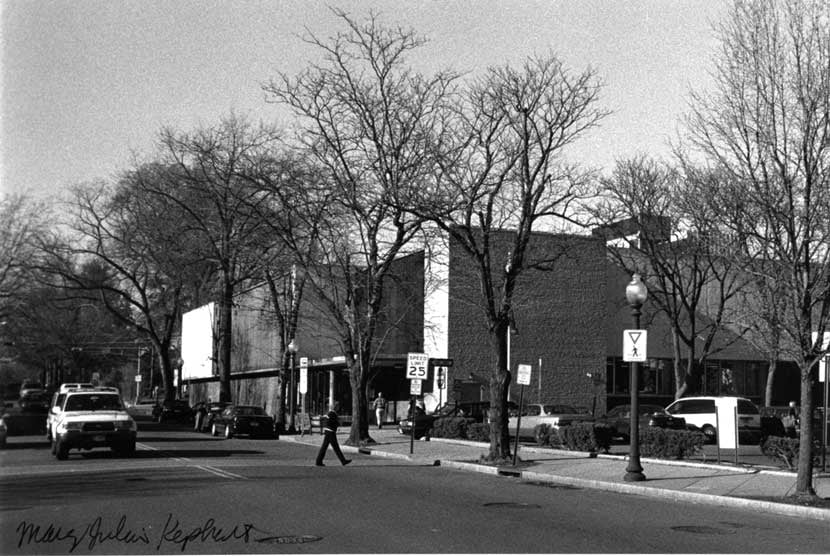 Princeton Public Library in 2002. Image courtesy of Studio Hillier LLC
Princeton Public Library in 2002. Image courtesy of Studio Hillier LLC
I'd never been a library director, but I had spent some time there as the interim director, and I had some ideas about how we might be able to reposition the library in the community so our project could advance.
A lot of those ideas meant that the library had to be more connected to the community, really engaging with people around issues important in Princeton at the time: reimagining our town and its redevelopment, planning for the integration of new and future technologies, thinking about societal changes and how they were affecting library use, challenging long-held ideas about the library’s services and collections, and how that should inform our thinking in planning a new library.
Not only were we thinking about how best to improve our physical space, but we were also thinking about the library experience we wanted people to have when they walked through the door. The Board of Trustees was committed to the idea of building the library of the future. They trusted that I could provide the leadership to help that transformation take place. Princeton really wanted this library project to be about the future, not about a bigger, better, library of the past. And, they wanted the project to be done in 5 years, from concept to completion.
How did you manage to get the carte blanche? Was there a lot of persuasion that you had to go through with all the relevant stakeholders?
Once we agreed on the site for the new library, which turned out to be to build a new library building on the existing site, we had surmounted a major project hurdle. Up to that point, there had been multiple proposed site locations along with an extensive list of reasons not to support construction. Turns out the site we occupied, a prime location in the central business district, was the perfect place.
Then the conversation turned to capital and operating funding. We were asked to raise US$12 million in private support for the building project. The library had no significant private support, but I told the Board and governing officials not to worry; we could raise all the money. I felt confident that the concept of the new library becoming the “community’s living room” would provide the traction we needed to convince prospective donors to support us.
The last big hurdle was parking. Parking is a big issue in New Jersey and most suburban communities. There is never enough, and everyone wants their car to be adjacent to the front door. We worked closely with the mayors of Princeton Borough and Princeton Township to devise a parking solution that would create a win-win for everyone. The town built a parking garage to solve the problem. We leveraged donations that were conditional on the resolution of the parking problem to influence local decision-makers.
This project also benefited from talents from a great team of people who were in the right place at the right time. My board president was a proven real estate developer and was able to negotiate the land development deals necessary for the new library. Another member of the team was really great with details; there are at least 30,000 details you have to pay attention to when you're trying to create a library. The Princeton Borough mayor was a visionary who saw the library as the anchor for a larger redevelopment project in Princeton to make it a more walkable downtown.
And, in myself, we had an out-of-the-box thinker — someone who was willing to challenge the status quo on every single aspect of library design, services, and operations, and who could talk about that in a compelling way and make people want to have it as opposed to clinging to the traditions of the past.
So, we had four people on our team who were focused on the future, who passionately believed in the project, were committed to doing everything to get it done, and a plan for doing it. We communicated exceptionally well with each other, created our message, and sharpened it in a way that became compelling for people who might not have ever thought about a new library as being an exciting thing.
A library seeing itself as a community living room was a powerful idea at that time, but you've also created a café in the library. Those broke the two main tenets in the traditional library: no food or drink and be quiet.
Right. When we first began talking about the café, there was opposition from the community. Fear that people would spill coffee or tea on the library’s books, that it would be noisy and dirty.

While the library was under construction, we moved to temporary quarters in a recently vacated bookstore/café. The bookstore had moved out and the café remained after we moved in. Everyone loved the café and soon became concerned that we hadn’t planned enough seating for the new library café. Moral of this story, model things you want to try – turns out people may like it.
Looking back, what were you most proud of?
In 2019, these things will sound simple and silly, but they were big for Princeton at the time.
We significantly increased library use.
When I got to Princeton, the number of items that were borrowed by the community had stagnated. So, I challenged the staff to think about how they could increase borrowing. The library staff didn't buy many of the books that were on The New York Times Best Sellers’ list and never purchased books about sports. The conventional wisdom was that people who live in Princeton were too smart to read books by Danielle Steel or Stephen King.
But we went ahead and increased the amount of money we were spending on bestsellers, and guess what happened? People in Princeton wanted to read the same stuff that everybody else in the country was reading. It was a small change, but it got more people in the library because they realized they could find and get what they were looking for.
We offered programming for adults.
We didn't do any kind of public programming for adults. We offered all the standard stuff that libraries were doing at that time — story hours and craft programs for children and activities for teens. But we didn't offer any programming that would get adults out of their own living rooms and into the library.
The very first adult program we did featured a belly dancer. My staff was appalled that I would do something that was considered sleazy. The belly dancer came, 100 people filled a room that fit 50, the belly dancer did her thing, and the next thing I knew everybody was up and out of their seats gyrating with the belly dancer and enjoying themselves.
That experience gave me the tools I needed to convince the staff to invest more in those kinds of events to get more adults into the library. We needed to reintroduce people to the library.
We made the library a destination.
As we put more money in programming and resources, people began to notice that the library was doing things differently. It wasn't just the same old, tired mid-century library they had always thought of. It was lively. It was vibrant. People were calling me; they were talking about it with others. They were saying things like, "Oh, you won’t believe what the library is doing." That was very key to our success — getting people to rediscover and rethink their relationship with the institution.
And providing things that the patrons as human beings really wanted — services that they actually used.
Yes, exactly.
We were fortunate to have a wonderful relationship with the staff at Princeton University. They were obviously early adopters of the internet with much faster internet than any public library could have hoped to have at that time, and they shared it freely with us. We were way ahead of other libraries in terms of offering people uninterrupted access to the internet that was 100 times faster than their AOL dial-up connection at home. The university provided that without charge for many years, which was wonderful.
We offered them books they wanted to read when they wanted to read them. We changed our hours to make it more convenient to come to the library. We created customer-friendly use policies. We offered after school homework assistance and exam prep at the library, installed a Redbox DVD dispenser available 24/7, café service, career counseling, employment assistance, citizenship prep and legal advice on immigration issues, hosted community forums about race, hosted a human rights and environmental film festival, and embraced new technologies to enhance the service experience.
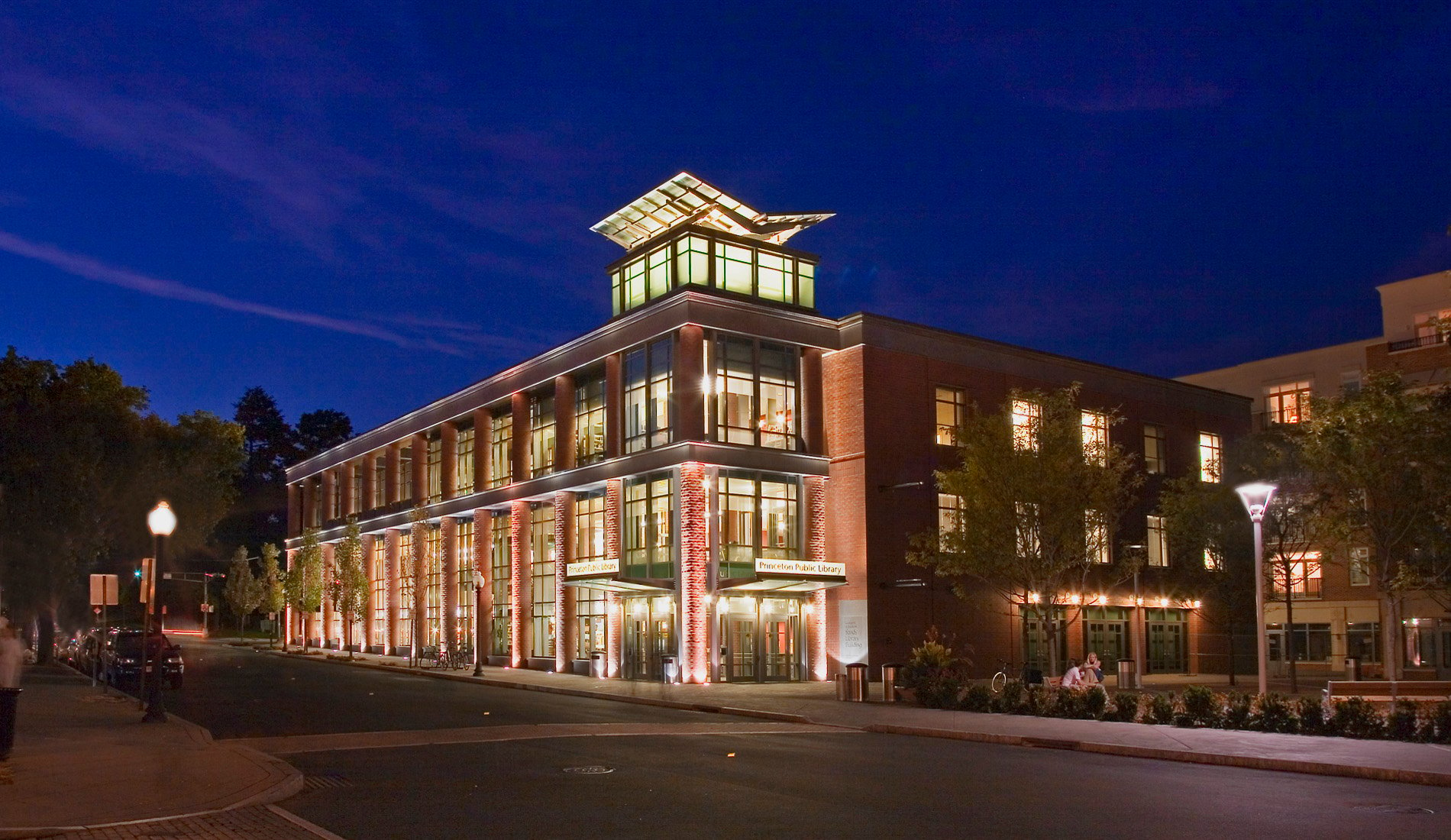 The new Princeton Public Library (2004). Image courtesy of Studio Hillier LLC
The new Princeton Public Library (2004). Image courtesy of Studio Hillier LLC
What do you wish you had done differently?
I might have designed the building in a slightly different way if I knew then what I know now, but I think generally for where we were at that time, that was an appropriate design, and it has held up remarkably well in the 16 years that it's been open. I would have made the design a little more architecturally interesting. The building was designed with maximum flexibility and with the thought that every 10-15 years that the interior space would be redone. We just finished our “2-Reimagine” project in 2017. That project completely redesigned the library’s adult space and was a test of the flexibility of the original design.
Interesting. Shifting gears a little bit. What do you think is the role of associations like ALA, or IFLA is today, and how has it changed over the past few years?
ALA and IFLA have to energize their members and mobilize them to be the change agents who will transform libraries for the future. Like every industry, libraries are dealing with major disruption and the choices that our working professionals and leaders make today will determine the long term survival of libraries or their demise.
Becoming a transformational change agent may not always coincide with an individual member’s interests which may be linked to their own professional advancement or exploring an esoteric aspect of librarianship. ALA and IFLA need to focus members on big-picture thinking that will shape libraries for the future. If our professional associations fail to energize their ranks and focus them on the issues that are vital to the people who use and can benefit from libraries we will not survive.
Part of that change can occur by disrupting the way our professional associations are organized. I’m not familiar with what IFLA is doing in that area, but certainly the next generation of librarians in ALA are pushing back on some of the long-held organizational structures, and saying, "That doesn't work for us. We want to do it differently." As long as the associations remain focused on big, important issues I think they'll be okay, but it requires vigilance on the part of association managers who need to think about the value proposition of association membership and running conferences.
Going back 13 years when you were president of the ALA, what was your experience? What goals did you want to accomplish, and how did you go about achieving those?
I came into the presidency with a very specific agenda with things I wanted to accomplish. I was told on several occasions that it wasn’t possible to do everything on my list in the time that we had. But I'm not a person who accepts “not possible” as an answer.
So, I worked with closely with ALA leaders and staff to make sure that the things that I wanted to do would be completed during the 24 months I had to advance my agenda. That included the launch of the ALA Emerging Leaders program, the establishment of “ilovelibraries.org” – a website about libraries and the amazing things that go on there for the public, a conversation about setting a national library agenda, and specific ideas for transforming libraries.
As ALA president, you automatically have positional power, but try getting 60,000 people to agree on anything, and one quickly is humbled by what it takes to get things done. I used my abilities as a persuasive leader to build consensus and support for my agenda. I did as much as I could do in the time allotted to me. ALA has continued the library transformation theme with its Libraries Transform campaign. I try to have some influence in keeping that discussion going.
We'll come back to transformation in a few minutes. Moving on…
As you know, there’s been a growing trend in the proliferation of fake news and declining information literacy. In your opinion, how important is it to provide a diverse and global selection of newspapers and magazines in today's libraries? And what do you see as the core value of those publications?
I think newspapers and magazines are very important, probably more so than ever before. Every day we learn about another newspaper or magazine that has folded; it’s frightening. Because what I see is the consolidation of “news” into the hands of a few influential publishers who have the potential to shape our views and manipulate information. A free press is essential to a healthy democracy. But the challenge is that now there are many alternatives for getting news and some are eager to make it up in order to further their own agenda. We also have a populace who is far less discerning when it comes to reading the news and who easily falls prey to disinformation campaigns.
Libraries need to position themselves to be trusted news and information sources. That means in-library and remote access to print and digital newspaper and magazine subscriptions with unlimited licensing at a price that libraries can afford. Any library — college, university, public, or school — could bring the news to life in the library by bringing in commentators or hosting conversations about something that's in the news.
During the 2000 presidential election, we invited our community to watch the election night returns together at the library and asked a well-respected political scientist to moderate and share her insights about the results. I offered to keep the library open until the election was over. The turnout for this event was amazing, standing room only. People were engaged in conversation and debate, and as the evening wore on distressed by the outcome. At 2 a.m. we closed the library since it was clear that the election would not be decided that day. The library played a vital role in helping our community understand the news and see history in the making.
Right now US libraries have a great opportunity to offer civic education (it’s no longer taught in public schools), to play that role in their community and be the place that brings news, issues and people together, to help them understand our world, shape an informed point of view, and work toward a better future. That's a really powerful idea. And certainly, a freely available diverse and global selection of newspapers and magazines in libraries can help shape that conversation.
Perhaps this upends the library’s traditional neutral role. But I think the era of neutrality is over. I’m an advocate of getting accurate news in the hands of people. Get them talking about it, and help them understand what they need to do to be an informed citizen.
There's a lot of debate these days about free access to information. For every paid source, there’re a few dozen free sources available on the exact same subject. So how does that correlate to a publisher's need and desire to be paid for their content? Do you have any thoughts on how the two positions can be reconciled in some way?
I'm not an expert on this by any means, but I believe that writers and content producers and the people that distribute that content need to be compensated for what they're doing. The information distribution model today is much more sophisticated and allows for information to be shared more freely. But yes, they do deserve to be paid for the work that they're doing, and the intellectual content that they're creating for us.
Paywalls discourage people from reading the content, so that is not a solution. Social media providers could compensate the content creators on behalf of their readers, but that may mean the content is not accurate or reliable. Governments could establish content compensation funds that would provide offsets to the cost of content creation. All of these ideas would be complicated to administer.
The cost model can't be so prohibitive that libraries can't afford to buy the information. The New York Times in-library digital subscription is a good model. Anyone in the library can access the content with a digital device, and a limited number of people can actually access the online content and read it at home. The New York Times has been great at testing new models for content development and pricing.
Do you see a role for associations in lobbying for libraries, setting rules of the game, or setting certain parameters around what the cost of that should be?
Yes, the associations should work with publishers to develop a product and pricing model that gets the news out to people and in their hands. Enabling libraries to push content out to their patrons is beneficial — beneficial to libraries and the role they play in society, to democracy as a whole for its survival, to all of us who need to be informed, and to the publishers to get content distributed more widely. So, yes, I think the associations can play a really important role.
What we’re seeing is publishers trying to build their direct consumer businesses through libraries, viewing patrons as targets for acquisition. But library patrons are often a very different audience than regular subscribers. Many patrons use library services because they either can't afford to pay for news, or they want to have access to a broader range of sources.
I think everybody needs to work together, understanding that the number of people who are using libraries is far less than the number of potential subscribers, publishers could have for their newspapers.
Absolutely. In the face of all the technological changes we see, changes in consumer behavior and user expectations, along with funding cuts, what do you think libraries need to do to sustain themselves going forward?
There's the inherent eternal problem of libraries never having enough money. Many never recovered from the recession. They're not even at their pre-recession level, so they're hurting. But what that means is you can't do business as usual. You have to make tough decisions about the things you've always done versus the right thing to do going forward.
So, for me, a lot of it is about change management and transformation. Some of the things libraries are doing, they should have stopped doing a long time ago. Most of them are getting pretty smart about it. But maintaining hugely extensive reference collections, for example, that no one is looking at anymore: Stop. And suddenly you're going to have $75,000 back in your budget. Complex practices around borrowing materials, interlibrary loans, and overdue notices — stuff that takes a whole lot of staff time — these should stop. Many libraries have eliminated overdue fines because they’re not worth the costs and they're a barrier to access.
I think the point we're at right now is that we're examining basic practices and asking what are the things that make sense to move forward with, and what are the legacy services that we can let go of because they've run their course. They're just not things that people want anymore.
You've worked with over 150 libraries in helping them transform themselves. What were the biggest challenges that you faced with libraries that you helped transform?
It's about change, resistance to change, doing things differently, and thinking differently about the relationship with the community. Being afraid to take risk, being able to say what's really needed, and being able to fight for what you believe is right to serve your community. Failure to understand the community and to act in an appropriate way are the two big issues.
And what are some of the best practices that help to overcome that? When is the light bulb moment when you see in their eyes, “Oh, yes, now we get it"?
I think it is when they see some immediate, positive reaction to something they've done. It may be something that they were resistant to trying, and they try it, and all of a sudden, it's hugely popular, and they say, "Wow, that was really great." So, it's kind of like dipping your toe in the water, and getting some positive feedback, and saying, “It's okay. The world's not going to end if I do this. Maybe we can try something else.” It’s about not being afraid.
In terms of governance, and management structure, has there been any real change to those in the last 20 years, or are we still seeing what existed before the age of the internet?
Because of the influx of younger library workers, there is more of an emphasis on teamwork and collaborative projects. And with some libraries, there is less hierarchy now.
Millennials work differently than baby boomers. And that's a good thing. I think each group is benefiting happily from their inter-generational interactions, but also learning from each other.
I also think there's more of an emphasis on project management and being able to take it from inception to delivery. So, I think it's a little more action-oriented, and that's a good thing.
If there's one piece of advice that you'd give to a library (public and academic) what would it be?
Listen. Listen to your community. Listen to the people who are using your library. Pay attention to what they're doing inside your building. Pay attention to what they're doing outside your building. Think about the trends in your community, or on your campus, or what you're reading about in the newspaper that can help you turn your programs into something that's responsive and supportive of what people need right now.
In every industry and every vertical that we work in or with, be it publishing or travel and others, the recurring theme is listening to people, listening to the individuals who are the customers, the patrons, et cetera. It’s slowly becoming more of an action item as opposed to just a topic of conversation. That's encouraging to see, but what's interesting for us is that wherever we are as service providers, we're still talking to that same individual. And if we don't understand what that person wants and needs, and how we can help that person, we won't be able to get to that person at the end of the day.
I live in New York City, and I get a lot of my information about new product development from the ads on the subway. Every week I see ads for new start-up businesses — whether they’re amenities delivered directly to your home, like meal plans, or products mailed to you like ladies’ shaving kits.
I'm endlessly fascinated by the number of new start-ups, and why they exist and what informed that decision. Who said it would be a better shaving experience for me if I deal with this company that's going to send me a razor and cartridges directly to my home rather than going to the drug store?
I’m sure that a lot of these start-ups have done focus groups and surveys and market analysis to inform their products, but ultimately someone is making a bet that a different, more convenient product is worth the try.
Librarians need to do a better job of listening to their customers and an even better job of anticipating their needs and responding quickly.
Do you think libraries are doing a good enough job communicating their value that they bring to the community?
Absolutely not. Some of that has to do with the demise of the local newspaper. Libraries were dependent on local newspapers to publish notices or run press releases about their offerings. Now that the papers are gone, they've lost that outlet. Libraries have to utilize new options - social media, email newsletters, paid ads on Google, and targeted marketing and promotion campaigns. Some are doing it, but some don't have a clue how to do it, and so I think that's a problem.
You spent a lot of time being a librarian and working with libraries as a consultant. What's next for you?
Hopefully retirement. J I'll continue to work with libraries in a consulting capacity and try to do my small part in transforming the clients that I have now, and helping them see a new future.
Thank you so much, Leslie, for this very educational and insightful interview. I learned a lot and I’m sure many of our readers have as well.
For those readers who want to learn more or get some further guidance from Leslie before she retires, you can reach her here:
Leslie Burger, Partner
Library Development Solutions
lburger@librarydevelopment.com
About Leslie Burger
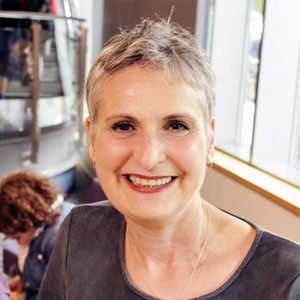 Leslie Burger is the founding partner of Library Development Solutions, a New York City-based consulting firm founded in 1991.
Leslie Burger is the founding partner of Library Development Solutions, a New York City-based consulting firm founded in 1991.
Until January 2016 she was the executive director of the Princeton Public Library (NJ) where she helped plan, design and secure the funding required for a new 55,000 square foot library that opened in 2004. That project was the anchor and driver for a downtown redevelopment project that resulted in a mixed-use building, parking garage, and public square.
During her last 18-months as Princeton’s executive director, she led the effort for Princeton’s “2-Reimagine” project, a gut renovation of the library’s primary space for adults including the overall concept and design, securing community support, and raising US$3.2M in private funding. A proven fundraiser, Leslie raised more than US$31M during her tenure at the Princeton Public Library.
Through her consulting practice and employment, Burger has dedicated her entire career to transforming libraries. In addition to leading the Princeton Public Library, she served in leadership positions at the Bridgeport (CT) Public Library, Connecticut and NJ State Libraries. In her consulting practice, she’s worked with more 150 libraries on strategic planning, community assessments, building evaluations and programs, organizational improvements and design, program evaluation, and implementation.
Leslie is also an adjunct faculty member at Rutgers, where she teaches management and leadership in the Library and Information Science concentration in the School of Communication and Information Master of Information Science Program.
Leslie served as president of the 65,000 member American Library Association from July 2006 through June 2007 where she sponsored a variety of initiatives focused on helping libraries transform communities they serve. She also served as president of the New Jersey and Connecticut Library Associations.
Leslie attended library school at the University of Maryland in College Park, Maryland and also has a master’s degree in organizational behavior from the University of Hartford, West Hartford, CT. She received her BS from Southern Connecticut State College.
She is the recipient of many honors and awards including:
- Beta Phi Mu, Library Science Honor Society
- YWCA of Princeton, Tribute to Women Award
- NY Times Librarian of the Year
- The University of Maryland, College of Information Studies, Alumna of the Year
- Southern Connecticut State University, Outstanding Alumna
- Rotary of Princeton, Community Service Award
- NJ Library Association, Librarian of the Year 2017
Leslie is a regular contributor to library publications including a monthly column in American Libraries (July 2006 – June 2007) and “Libraries for All Seasons and All Reasons,” American Libraries, March 2008.
This article was originally published in The Insider Magazine.


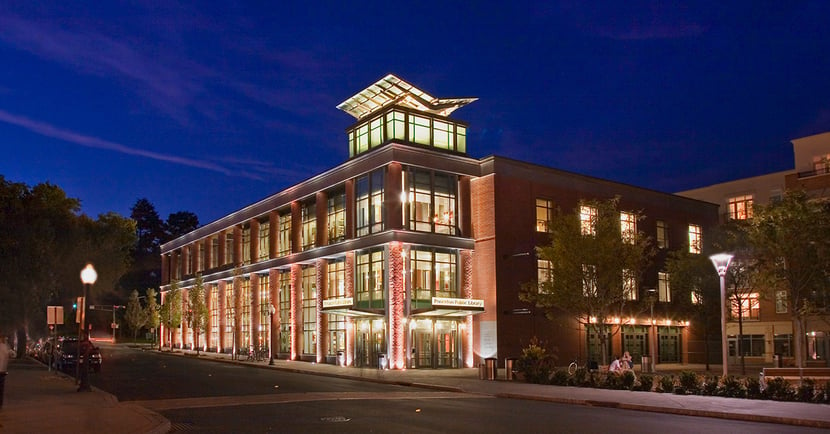

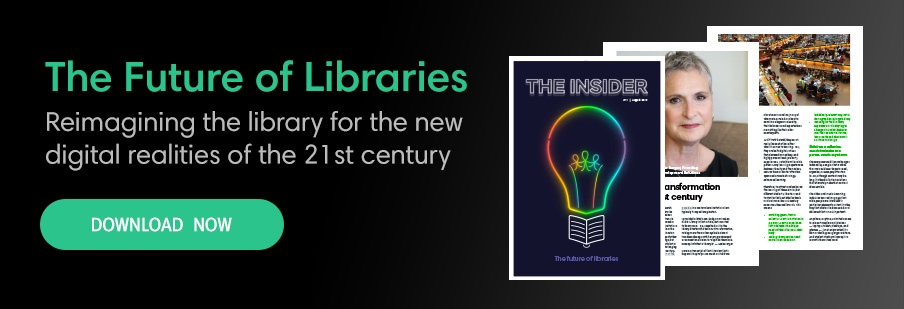


.png)
